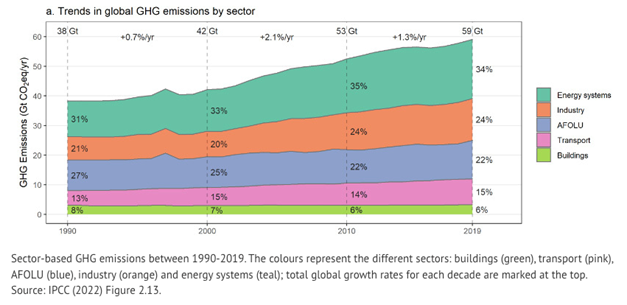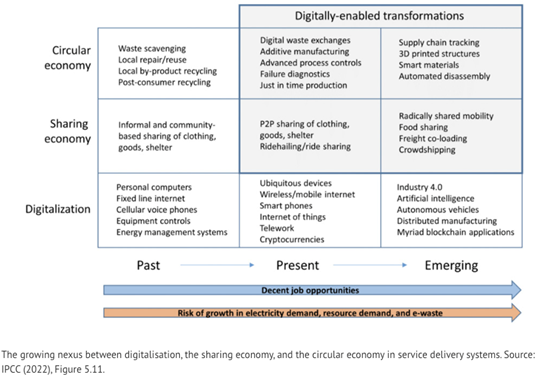The third part of the Sixth Assessment Report (AR6), Climate Change 2022: Mitigation of Climate Change, the Working Group III contribution, provides an updated global assessment of climate change mitigation progress and pledges and examines the sources of global emissions. Our Clean Energy Expert, Ganna Gladkykh, shares with the EERA community the report's main takeaways.
On April 4, the IPCC published the third and final part of the AR6 report. The first part, released in August 2021, explained how and why the Earth's climate is changing. The second part, published in February 2022, explored the impacts of climate change on humans and the planet. Finally, the third part discusses what humans can do to mitigate climate change. It assesses "the current state of knowledge on the scientific, technological, environmental, economic and social aspects of climate change mitigation" based on the literature published after 2015 when the previous IPCC AR5 report was released.
1. How different is the AR6 WG3 report from the previous versions of it?
- The WG3 AR6 report pays much more attention than AR5 to social, economic and environmental aspects of climate change mitigation actions, including institutional, legal and financial aspects.
- For the first time, the report includes chapters dedicated to cross-sectoral perspectives, demand, services and social aspects, technology development and transfer.
2. What are the main findings? Where are we standing with the current mitigation actions according to the report?
- Greenhouse gas (GHG) emissions continue increasing globally, even though the speed of the increase has slowed down.
- Current policy scenarios lead us to the average temperature rise from 2.2°C to 3.5°C in 2100. However, as climate system uncertainties are significant, we cannot rule out warming above 4°C.
- Limiting global warming to 1.5°C or 2°C would require rapid and deep GHG reductions in all sectors of the global economy. In addition to rapid GHG emissions reductions, carbon dioxide removal (CDR) will be unavoidable to reach net zero.
- Most of the existing transition pathways and scenarios overlook behavioural and cultural changes.
- The consumption emissions of the middle income and poor citizens in emerging economies are between 5-50 times lower than the emissions of the citizens living in high-income countries.
- Emissions vary widely with income levels within each country. The wealthiest 10% of people are responsible for 34-45% of consumption-based household emissions. That wealthiest 10% are present on all continents.
- Consumption patterns and the associated emissions are affected by socioeconomic status, access to public services, individual choice, and values.
- It is crucial to understand how socioeconomic factors affect mitigation efforts to succeed in climate mitigation.
- Decoupling of GHG emissions and use of natural resources from the economic growth prove to be "feasible" at the national level. However, there is no evidence and thus high scepticism that "absolute decoupling can be achieved at a global scale".
- Energy efficiency improvements have created decarbonisation gains in some sectors. But these gains "have been largely wiped out by increases in demand for goods and services".
3. How does the current GHG emissions distribution across different economic sectors look like?
- Since the AR5 report's publication, GHG emissions have increased across all sectors in absolute value. The shares of the emissions per sector remained almost the same.
- When emissions from electricity and heat are added to direct emissions from the other sectors, the industry's emissions share increases to 34%, and buildings' to 16%.
- Around 22% of global GHG came from agriculture, forestry and other land use (AFOLU).
- Food systems are responsible for 42% of global greenhouse gas emissions.

4. What are the main directions for further mitigations efforts?
- "Demand-side" measures and consumption patterns change crucial to reducing high-emitting goods and services uptake.
- Behavioural and cultural changes must be addressed urgently in the transition pathways and scenarios. The report highlights this central review offering substantial literature on consumption reduction actions.
- The "avoid-shift-improve" approach is encouraged. For example, "avoid" options could include not using a car and cutting back on flights; "shift" could lead to switching to plant-based diets and using public transport; "improve" could include buying an electric car or a heat pump.
- Mitigating emissions in food systems is one of the crucial policy leverage points for reducing global GHG emissions, as the food supply chains interlink energy use, land use, water use, and lifestyles.
- It is crucial to target high-emitting individuals and groups within countries rather than all people living in high-emitting countries since one-third of the top 10% of emitters live in developing countries.
- Demand-side measures should be taken as part of "transformative megatrends", such as the sharing economy, the circular economy, digitalisation, and other emerging trends.

- Reducing life quality due to climate mitigation efforts should not be a concern for policy-makers. "Decent living standards" – a benchmark of minimum material conditions for human wellbeing – are "achievable by implementing high-efficiency low demand mitigation pathways".
- Removal of all fossil fuel subsidies would cut global GHG by up to 10% by 2030 and boost public revenue and macroeconomic performance. However, the report adds that the fossil fuel industry lobbies strongly to maintain the subsidies.
- The features of systems that can effectively tackle climate change include proportional representation, broader public participation in decision-making, and few organisations involved in lobbying the government.
- Applying just transition principles by securing livelihoods and addressing inequalities while building a low-carbon future is "essential to reducing climate risks and addressing sustainable development priorities". This is crucial for not replacing "old forms of injustice with new ones".
- Individual climate mitigation actions are "necessary but insufficient" to ensure a just transition. It is crucial to overcome current trajectories, fossil-fuel dependence and resistance from "industries and actors benefiting from the current system".
- Climate finance from richer countries "is likely to be key to a successful low-carbon transition globally".
5. Where does the energy sector stand in the mitigation efforts?
- Low-carbon energy can by now save money due to rapid cost reductions in key technologies over the past decade.
- No more fossil fuel infrastructure must be built, and existing fossil fuel infrastructure must be decommissioned. Emissions from the existing fossil fuel infrastructures already exceed the carbon budget available if we are to limit global warming to 1.5°C by 2100.
- Renewable energy, including wind, solar and bioenergy, supplies 30-70% of energy in the below-2°C pathways and above 40% in the 1.5°C pathways.
- Electrification, not hydrogen, is "expected to be the dominant strategy in buildings as electricity is increasingly used for heating and for cooking". As a general rule for all sectors, it is more efficient to use electricity directly and avoid significant conversion losses, as in the case of hydrogen production.
- Climate change will alter hydropower output, bioenergy, the efficiency of fossil and nuclear power plants, and the demand for heat and cooling. However, it "will not affect wind and solar resources to the extent that it would compromise their ability to reduce emissions".
- The use of bioenergy can lead to both emissions increase and decrease. It depends on "the scale of deployment, conversion technology, fuel displaced, and how, and where, the biomass is produced".
- Electric vehicles offer the most significant low-carbon potential for land-based transport. The feasibility of a large scale deployment of hydrogen fuel cell vehicles is lower.
- Low-demand pathways can significantly limit the need for technologies with high uncertainty, such as bioenergy with carbon capture and storage (BECCS).
- There are "growing concerns about resource availability, labour rights, non-climate environmental impacts, and costs of critical minerals needed for lithium-ion batteries".
This is the first IPCC report that explicitly mentions societal transformation as the key to achieving climate mitigation goals. Society has not progressed much in this objective because we have treated social aspects as secondary to the development of technologies. Targeting inequality, powerful fossil fuels lobbies and fossil fuel subsidies, undemocratic decision-making, and challenging the economic growth paradigm is crucial if we want fast progress in tackling climate change.